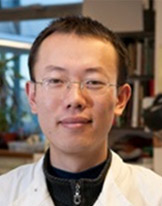TEAMS
> Research Interests
Mainly on the sythesis, regulation and evolution of flavonoids in Scutellaria baicalensis and related species.
1. the biosynthetic and regulation of flavonoids in Scutellaria baicalensis;
2. the evolution of flavonoids biosynthetic pathway in Scutellaria L.;
3. The mechanism of flavonoids promoting health;
4. Collection of the germplasm resource of Scutellaria L.
> Major Ongoing Projects
1)the biosynthetic and regulation of flavonoids in Scutellaria baicalensis
Flavonoids metabolism is plant secondary metabolic pathways. There is a special flavonoid biosynthetic pathway in root of the species of lamiaceae family such as Scutellaria baicalensis, which is different from aerial part. The special pathway sythetise baicalein and wogonin, which have antibacterial and inhibition antitumor activity. The group focus on the searching the genes involved in the biosynthetic pathway and regulation mechanism. We also Construct the transcriptome database. At the same time, we get the high yield hairyroots of baicalein and wogonin with synthetic biology, transgenic and gene editing method.
2)the evolution of flavonoids biosynthetic pathway in Scutellaria L.
the flavonoids biosynthetic pathway in the root of the species of lamiaceae family such as Scutellaria baicalensis is different from the traditional flavonoids biosynthetic pathway. The group will analyse the related genes with bioinformatics tools to research the evolution of the special pathway.
3)The mechanism of flavonoids promoting health
Scutellaria baicalensis Georgi, or Huang-Qin,has been used in China for more than 2000 years as a traditional medicine. Bencao Gangmu (Compendium of Materia Medica) which was first published in 1593, reported that Scutellaria baicalensis had been applied in the
treatment of inflammation, respiratory tract infections, lung and liver problems. Modern
medicinal study shows that S. baicalensis is cytotoxic to a broad spectrum of human cancer
cell lines while leaving healthy cells untouched. The group will research the effects of baicalein and wogonin on the immune activity.
4) Collection of the germplasm resource of Scutellaria L.
The group collected more than 10 species of Scutellaria L..
> Selected Publication
1. Zhao, Q#. Cui, M-Y#. Levsh, O. Yang D-F. Liu, J. Li, J. Hill, L. Yang, L. Hu, Y. Weng, J-K. Chen, X-Y. Martin, C. (2018) Two CYP82D enzymes function as flavone hydroxylases in the biosynthesis of root-specific 4′-deoxyflavones in Scutellaria baicelensis. Molecular Plant, 11(1): 135–148.
2. Zhao Q, Zhang Y, Wang G, Hill L, Weng J-K,Chen X-Y, Xue H, Martin C.( 2016) A specialized flavone biosynthetic pathway hasevolved in the medicinal plant, Scutellaria baicalensis. Science Advances, 2, e1501780.
3. Zhao Q, Chen X-Y, Martin C. (2016) Scutellaria baicalensis, the golden herb from the garden of Chinese medicinal plants. Science Bulletin.61(18):1391–1398.> Team Members
 | Principal Investigator (PI) 3888 Chenhua Road, Songjiang Shanghai 201602 China |
Experience
2016 –present professor in Shanghai Chenshan Plant Research Center
Recently published
1. Zhao, Q#. Cui, M-Y#. Levsh, O. Yang D-F. Liu, J. Li, J. Hill, L. Yang, L. Hu, Y. Weng, J-K. Chen, X-Y. Martin, C. (2018) Two CYP82D enzymes function as flavone hydroxylases in the biosynthesis of root-specific 4′-deoxyflavones in Scutellaria baicelensis. Molecular Plant, 11(1): 135–148.
2. Zhao Q, Zhang Y, Wang G, Hill L, Weng J K, Chen XY, Xue H, Martin C. (2016) A specialized flavone biosynthetic pathway has evolved in the medicinal plant Scutellaria baicalensis. Science Advances p4. Publisher’s version: 10.1126/sciadv.1501780
3. Garcia-Seco D, Zhang Y, Gutierrez-Mañero FJ, Martin C, Ramos-Solano B. (2015) Application of Pseudomonas fluorescens to Blackberry under Field Conditions Improves Fruit Quality by Modifying Flavonoid Metabolism. PLoS ONE 10 (11) pe0142639 Publisher’s version: 10.1371/journal.pone.0142639
4. Acheterfeldt S, Traka M, Martin C, Vauzour D, Kroon P. (2015) Do anthocyanins in purple tomatoes reduce the risk of cardiovascular disease? Proceedings of the Nutrition Society 74: E85. doi: http://dx.doi.org/10.1017/S0029665115001007
5. Zhang Y, Butelli E, Alseekh S, Tohge T, Rallapalli G, Luo J, Kawar PG, Hill L, Santino A, Fernie AR, Martin C. (2015) Multi-level engineering facilitates the production of phenylpropanoid compounds in tomato. Nature Communications 6 p8635. Publisher’s version: 10.1038/ncomms9635
> Research Assistants(in alphabetical order)
 | Cui Mengying |  | Fang Yumin |
 | Liu Jie |  | Zhao Qing |